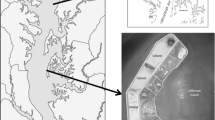Abstract
The Poplar Island Dredged Material Placement Site in Talbot County, Maryland is proposed to be used for the restoration of Poplar Island and for the creation of desirable habitats lost through erosion of Poplar Island by the beneficial use of clean and uncontaminated dredged material from the Chesapeake Bay approach channels to the Port of Baltimore. The Poplar Island baseline environmental assessment studies included among others, seasonal water quality, benthic community, and benthic tissue contaminants, that were carried out by the Maryland Department of the Environment, in cooperation with the University of Maryland, from September 1995 to July 1996. The purpose of the study was to document the present-day levels of nutrients, trace metals, and organic contaminants in the area to establish a baseline against which subsequent levels and biological responses may be compared. The overall results of the study indicate that Poplar Island and vicinity areas are non-impacted in terms of water quality and benthic tissue contamination. The nutrient levels in the water column were below average for this region of Chesapeake Bay, while the trace metals and organic contamination in the benthic tissues were comparable to other sites within Chesapeake Bay that are not impacted by direct inputs. Concentrations were equivalent or lower than those found at Hart-Miller Island, a disposal facility outside Baltimore Harbor, Maryland containing dredged material.
Similar content being viewed by others
Literature Cited
Bilyard, G. andS. Becker. 1987. Recommended protocols for sampling and analyzing sub-tidal benthic macro-invertebrate assemblages in Puget Sound. United States Environmental Protections Agency Region 10, Office of Puget Sound, Seattle, Washington.
Boesch, D. F. 1973. Classification and community structure of macrobenthos in the Hampton Roads area, Virginia.Marine Biology 21:226–244.
Brower, J. E. andJ. H. Zar. 1984. Field and Laboratory Methods for General Ecology, Second Edition. William C. Brown Publishers, Dubuque, Iowa.
Chesapeake Bay Program. 1994. Chesapeake Bay basinwide toxics reduction strategy reevaluation report, Report #CBP/TRS 117/94, Chesapeake Bay Program, Annapolis, Maryland.
Chesapeake Research Consortium. 1994. Chesapeake Bay Basin-wide Toxics Reduction Strategy Re-evaluation Report. Chesapeake Bay Program. CBP/TRS 117/94. Chesapeake Research Consortium, Inc., Edgewater, Maryland.
Dalal, V. P., C. Poukish, and J. E. Baker. 1996. Baseline Environmental Assessment of Poplar Island Beneficial Use Site, Talbot County, Maryland. Pre-Construction Analysis-Phase I Study. Maryland Department of the Environment, Technical and Regulatory Services Administration (MDE/TARSA Report #97-007), Baltimore, Maryland.
Dauer, D. M. andW. G. Conner. 1980. Effects of moderate sewage on benthic polychaete populations.Estuaries and Coastal Marine Science 10:335–346.
Environmental Protection Agency. 1979. Chemical Analysis of Water and Wastes. United States Environmental Protection Agency-600/4-79-020. Office of Water, Environmental Protection Agency, Washington, D. C.
Environmental Protection Agency/United States Army Corps of Engineers. 1995. QA/QC Guidance for Sampling and Analysis of Sediments, Water, and Tissues for Dredged Material Evaluations: Chemical Evaluations (EPA/USACE #823-B-95-001, April 1995). Office of Water, Environmental Protection Agency, Washington, D. C.
Ferrado, S. P., R. C. Swartz, F. A. Cole andD. W. Schultz. 1991. Temporal changes in the benthos along a pollution gradient: Discriminating the effects of natural phenomena from sewage-industrial wastewater effects.Estuarine, Coastal and Shelf Science 33:383–407.
Foster, G. D. andD. A. Wright. 1988. Un-substituted polynuclear aromatic hydrocarbons in sediments, clams, and clam worms from Chesapeake Bay.Marine Pollution Bulletin 19(9):459–465
Hart-Miller Island. 1997. Preliminary report to the Maryland Department of the Environment concerning the levels of organic contaminants and trace metals in clams and sediments collected in the vicinity of Hart-Miller Island, Maryland. Maryland Department of the Environment, Technical and Regulatory Services Administration, Baltimore, Maryland.
Klemm, D. J., P. A. Lewis, F. Fulk, andJ. M. Lazorchak. 1990. Macroinvertebrate field and laboratory methods for evaluating the biological integrity of surface waters. United States Environmental Protection Agency, Cincinnati, Ohio.
Ko, F-C. andJ. E. Baker. 1995. Partitioning of hydrophobic organic contaminants to re-suspended sediments and plankton in the mesohaline Chesapeake Bay.Marine Chemistry 49:171–188.
Kucklick, J. R., H. R. Harvey, P. H. Ostrom, N. E. Ostrom, andJ. E. Baker. 1996. Organochlorine dynamics in the pelagic food web of Lake Baikal.Environmental Toxicology and Chemistry 15(8):1388–1400.
Leister, A. andJ. E. Baker. 1994. Atmospheric deposition of organic contaminants to the Chesapeake Bay.Atmospheric Environment 28(8):1499–1520.
Morse, J. W., B. J. Presley, R. J. Taylor, G. Benoit, andP. Santschi. 1993. Trace metal chemistry of Galveston Bay: Water, sediments and biota.Environmental Research 36:1–37.
Pearson, T. H. andR. Rosenberg. 1978. Macrobenthic succession in relation to organic enrichment and pollution of the marine environment.Oceanographic Marine Biology Annual Review 16:229–311.
Rhoades, D. C., P. L. McCall, andJ. Y. Yingst. 1978. Disturbance and production on the estuarine sea floor.American Scientist 66:577–586.
Warwick, R. M. 1986. A new method, for detecting pollution effects on marine macrobenthic communities.Marine Biology 92:557–562.
Weber, C. I. 1973. Biological field and laboratory methods for measuring the quality of surface waters and effluents. United States Environmental Protection Agency. Cincinnati, Ohio.
Weisberg, S. B., J. A. Ranasinghe, L. C. Shaffner, R. J. Diaz, D. M. Dauer, andJ. B. Frithsen. 1997. An Estuarine Benthic Index of Biotic Integrity (B-IBI) for Chesapeake Bay.Estuaries 20:149–158.
Author information
Authors and Affiliations
Corresponding author
Rights and permissions
About this article
Cite this article
Dalal, V.P., Baker, J.E. & Mason, R.P. Environmental assessment of Poplar Island Dredged Material Placement Site, Talbot County, Maryland. Estuaries 22, 770–784 (1999). https://doi.org/10.2307/1353110
Received:
Accepted:
Issue Date:
DOI: https://doi.org/10.2307/1353110




